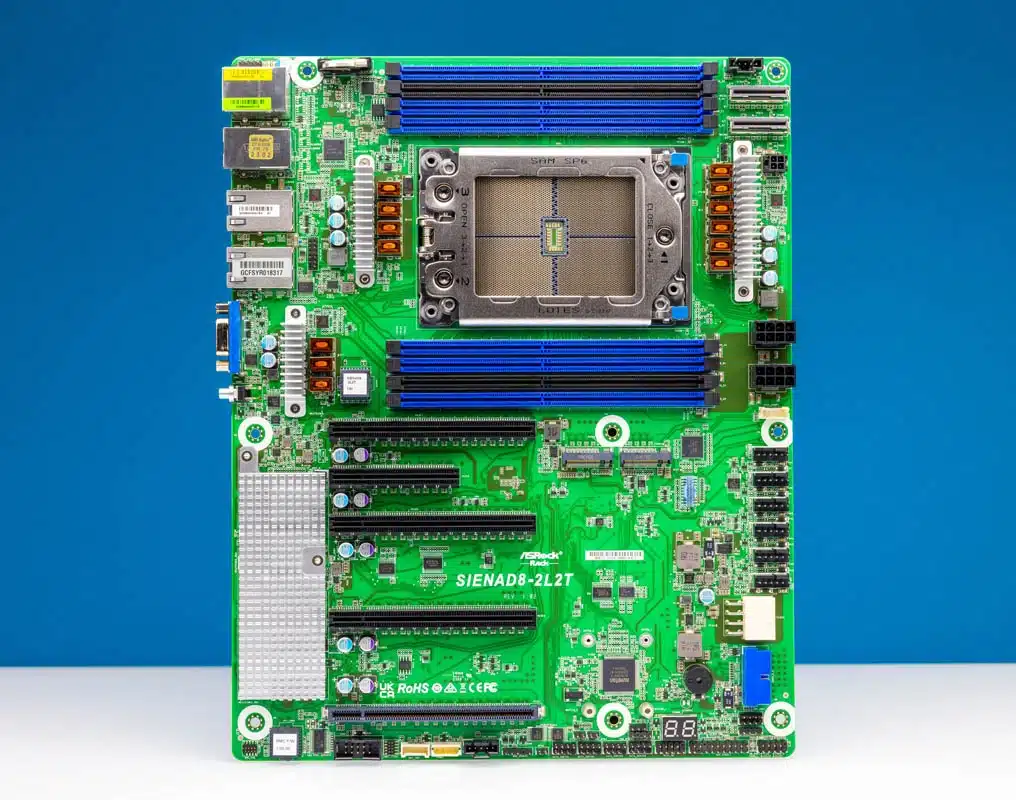Review of the ASRock Rack SIENAD8-2L2T: An AMD EPYC 8004 Siena Motherboard
ASRock Rack SIENAD8-2L2T, the ASRock Rack SIENAD8-2L2T showcases arguably one of the most uncomplicated structures the company has ever produced. It’s constructed around an AMD EPYC 8004 “Siena” CPU, purposely designed to reveal the platform’s features that might genuinely captivate our readership. Despite the design’s simplicity, it still flaunts a hint of ASRock Rack design panache familiar to our readers.
ASRock Rack SIENAD8-2L2T Overview
ASRock Rack SIENAD8-2L2T-In terms of dimensions, the motherboard adheres to the customary ATX 12? x 9.6″ size, rendering it comparatively smaller than some preceding Siena boards we’ve evaluated.
The centerpiece of the motherboard manifests in the form of an AMD socket SP6 (LGA 4844). ASRock’s intention with this motherboard was to create a potential custodian to upgrade a 1 DIMM per channel AMD EPYC 7001-7003 series configuration or conceivably an Ice Lake Xeon setup.
AMD provided us with several CPUs for use. The AMD EPYC 8534P 64-core 200W processor is what we are employing in this system for photographs. The AMD EPYC 8004 “Siena” series is captivating because it offers extensive I/O and as many as 64 cores in single socket platforms. ASRock Rack SIENAD8-2L2T-However, it utilizes Zen 4C cores and has less memory.
A prominent feature of the AMD EPYC 8004 series is the DDR5 memory configuration. It supports 6-channel memory, which is half that of the EPYC 9004 series. Despite it not strictly being a 1DPC or 2DPC design, ASRock Rack includes an extra two slots, allowing for eight DDR5 DIMM slots in total. This is especially advantageous for those needing to move from older generation Xeon E5, Xeon Scalable, Xeon D-2100, or initial generation EPYC 3000 or EPYC 7000 systems.
Speaking from an airflow point of view, this is an ATX server platform, thus it is optimized for front-to-rear airflow.
MCIO connectors have surged in popularity in the PCIe Gen5 era. ASRock Rack SIENAD8-2L2T, this system features two of them at the top edge of the board.
Unseen on the motherboard is a conventional 24-pin ATX power connector. Its place is taken by a modest 4-pin ATX Power connector. To deliver functionalities such as power on for the system, ASRock Rack incorporates an adapter from a 24-pin to this.
Instead, ASRock Rack has deployed two 8-pin 12V power inputs to fuel the board’s power. Based on our observations from the company, the typical 24-pin power connector is considered too bulky for creating dense designs, hence this has been the layout technique used by ASRock Rack for multiple years. ASRock Rack SIENAD8-2L2T, we guaranteed you some unique ASRock Rack style.
Six fan power headers are present, built for conventional 4-pin or larger counter-rotating fan designs. ASRock Rack SIENAD8-2L2T, these are conveniently situated at the motherboard’s leading edge, where the majority of fan partitions shall be located.
The motherboard’s bottom houses a POST code display along with a variety of headers.
One of the appealing features of this motherboard is its dual PCIe Gen5 x4 M.2 slots. Depending on the location of the mount, these slots could be either M.2 2280 (80mm) or 22110 (110mm).
ASRock uses a convenient thumb screw, but we would prefer a tool-less design for the mount point. Some manufacturers have already implemented tool-less M.2 mounting which not only secures the drive to the mount but also secures the mount to the correct spot on the motherboard. ASRock Rack SIENAD8-2L2T, this detail might seem small, but it could save a few seconds per installation.
This platform features four PCIe Gen5 x16 slots, with three of them supporting CXL 1.1. These slots can fit double-width cards and there is also an x8 slot. How all of the PCIe is connected will be explained in the block diagram section.
Here is another view of the PCIe slots. ASRock Rack SIENAD8-2L2T, we would like to highlight that full-length PCIe cards will obstruct the onboard M.2 slots.
Underneath the heatsink, you’ll find two important chips. The first one is the Intel X710-AT2 controller, which is used for 10GbE. The second one, sitting beneath, is the ASPEED AST2600 BMC. ASRock Rack SIENAD8-2L2T, a singular heatsink provides coverage for both chips.
An interesting aspect of the design is the inclusion of the Intel i210-AT NIC for 1GbE.
The rear I/O features the out-of-band management port. Additionally, it also sports a VGA and two USB 3 ports for local access. For connectivity, it includes two 1GbE ports and a pair of 10Gbase-T ports, providing a good combination of 1GbE and 10GbE.
ASRock Rack SIENAD8-2L2T, Let’s now proceed towards the block diagram.
ColoCrossing excels in providing enterprise Colocation Services, Dedicated Servers, VPS, and a variety of Managed Solutions, operating from 8 data center locations nationwide. We cater to the diverse needs of businesses of any size, offering tailored solutions for your unique requirements. With our unwavering commitment to reliability, security, and performance, we ensure a seamless hosting experience.
For Inquiries or to receive a personalized quote, please reach out to us through our contact form here or email us at sales@colocrossing.com.

